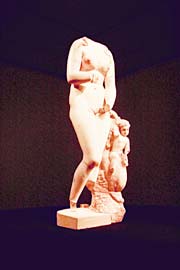
Venus and Eros riding a dolphin. The uniqueness of the statue is the preservation of its original colors
Yesterday, the Israel Museum unveiled to the public for the first time a rare and beautiful marble statue of the Roman goddess of love, Venus. The statue was discovered about a decade ago in the excavations of the ancient Beit Shean. The uniqueness of the statue, according to the museum's curators, is in the many remnants that remain of the original layer of paint that covered it. The museum hopes that the statue "Venus from Beth Shan" will become one of the most famous sculptures of its kind in the world. The museum noted that a similar statue, of Aphrodite, was recently sold at an auction at Christie's to the Prince of Qatar, for a record sum of eight million pounds.
The statue, which dates back to the second century AD, was discovered in 1993 in the excavations carried out in the city's eastern bathhouse by archaeologists Prof. Gideon Forster and Prof. Yoram Tzafir from the Institute of Archeology of the Hebrew University. Venus appears in the position that earned her the name "modest Venus" (pudica), with her hands raised to supposedly hide her exposed breasts and pubes.
Beside Venus appears Eros, as a chubby boy, riding a dolphin. The most famous examples of sculptures of this type, known as the "Capitoline Venus", are currently displayed in museums in Rome and Florence. The statue "Venus from Beth Shan" was probably created in the great sculpture workshop, which operated in the city of Aphrodisias in Asia Minor (now Turkey). The weight of the statue is about half a ton, its height is 1.6 meters and its head, feet and hands are missing.
In the laboratories of the museum and the Antiquities Authority, they worked for years to restore the statue, which was discovered when it was broken into several pieces and inside a layer of travertine, a hard and compressed limestone that formed over the statue over the years. The restoration work included cleaning, joining the fragments and placing the statue for the display. The uniqueness of the statue is in the red, blue and yellow pigments that remain in different areas; On the chest, on the hair curls and on top of the figure of Eros and the dolphin.
Dodi Mbaruch, the chief curator of the museum for the Roman, Hellenistic and Byzantine periods, said that this is a statue with the best preservation of the original color from the Roman period, discovered so far in archaeological excavations in the world. According to him, the museum consulted with the best experts on color preservation on the question of how to prevent their fading. Finally, it was decided not to cover the pigments with a protective layer, but to display the sculpture in minimal lighting.
Prof. Forster pointed out that the statue stood in its place for about 400 years, of which about 150 years were when Beit Shean was under Christian rule. In the city, which was called Nysa-Scythopolis in the Roman period, there were two baths, temples, paved streets and many public buildings. At its peak, in the fourth century AD, Beit Shan had about 40 thousand inhabitants. The city was completely destroyed by an earthquake that occurred on January 18, 749.
